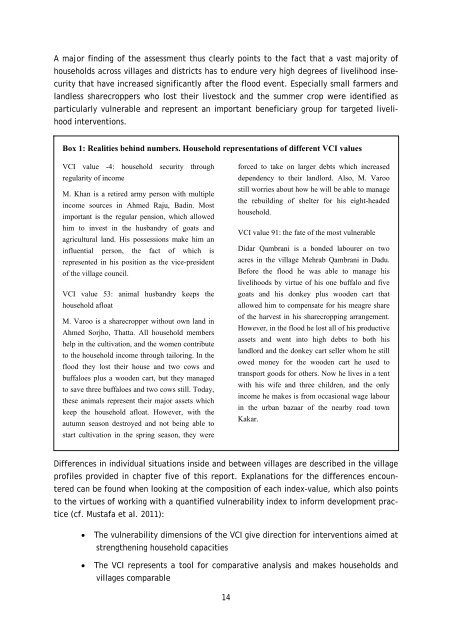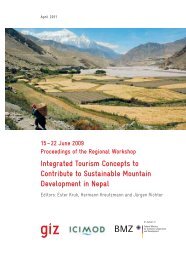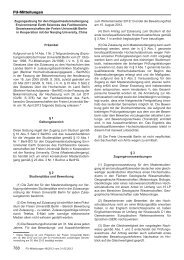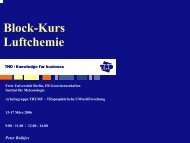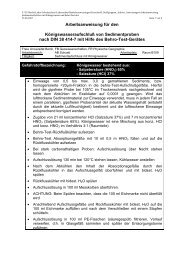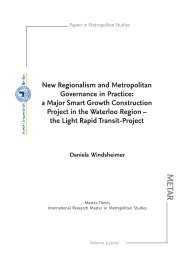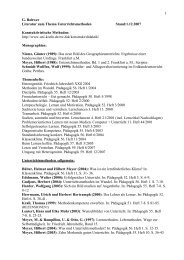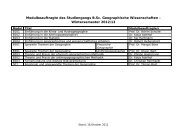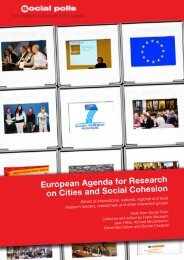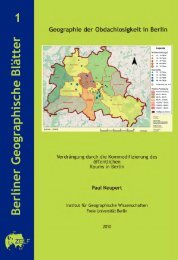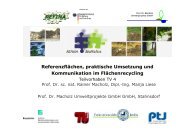After the Flood in Pakistan 38 Berlin Geographical Papers - Freie ...
After the Flood in Pakistan 38 Berlin Geographical Papers - Freie ...
After the Flood in Pakistan 38 Berlin Geographical Papers - Freie ...
Create successful ePaper yourself
Turn your PDF publications into a flip-book with our unique Google optimized e-Paper software.
A major f<strong>in</strong>d<strong>in</strong>g of <strong>the</strong> assessment thus clearly po<strong>in</strong>ts to <strong>the</strong> fact that a vast majority of<br />
households across villages and districts has to endure very high degrees of livelihood <strong>in</strong>security<br />
that have <strong>in</strong>creased significantly after <strong>the</strong> flood event. Especially small farmers and<br />
landless sharecroppers who lost <strong>the</strong>ir livestock and <strong>the</strong> summer crop were identified as<br />
particularly vulnerable and represent an important beneficiary group for targeted livelihood<br />
<strong>in</strong>terventions.<br />
Box 1: Realities beh<strong>in</strong>d numbers. Household representations of different VCI values<br />
VCI value -4: household security through<br />
regularity of <strong>in</strong>come<br />
M. Khan is a retired army person with multiple<br />
<strong>in</strong>come sources <strong>in</strong> Ahmed Raju, Bad<strong>in</strong>. Most<br />
important is <strong>the</strong> regular pension, which allowed<br />
him to <strong>in</strong>vest <strong>in</strong> <strong>the</strong> husbandry of goats and<br />
agricultural land. His possessions make him an<br />
<strong>in</strong>fluential person, <strong>the</strong> fact of which is<br />
represented <strong>in</strong> his position as <strong>the</strong> vice-president<br />
of <strong>the</strong> village council.<br />
VCI value 53: animal husbandry keeps <strong>the</strong><br />
household afloat<br />
M. Varoo is a sharecropper without own land <strong>in</strong><br />
Ahmed Sorjho, Thatta. All household members<br />
help <strong>in</strong> <strong>the</strong> cultivation, and <strong>the</strong> women contribute<br />
to <strong>the</strong> household <strong>in</strong>come through tailor<strong>in</strong>g. In <strong>the</strong><br />
flood <strong>the</strong>y lost <strong>the</strong>ir house and two cows and<br />
buffaloes plus a wooden cart, but <strong>the</strong>y managed<br />
to save three buffaloes and two cows still. Today,<br />
<strong>the</strong>se animals represent <strong>the</strong>ir major assets which<br />
keep <strong>the</strong> household afloat. However, with <strong>the</strong><br />
autumn season destroyed and not be<strong>in</strong>g able to<br />
start cultivation <strong>in</strong> <strong>the</strong> spr<strong>in</strong>g season, <strong>the</strong>y were<br />
14<br />
forced to take on larger debts which <strong>in</strong>creased<br />
dependency to <strong>the</strong>ir landlord. Also, M. Varoo<br />
still worries about how he will be able to manage<br />
<strong>the</strong> rebuild<strong>in</strong>g of shelter for his eight-headed<br />
household.<br />
VCI value 91: <strong>the</strong> fate of <strong>the</strong> most vulnerable<br />
Didar Qambrani is a bonded labourer on two<br />
acres <strong>in</strong> <strong>the</strong> village Mehrab Qambrani <strong>in</strong> Dadu.<br />
Before <strong>the</strong> flood he was able to manage his<br />
livelihoods by virtue of his one buffalo and five<br />
goats and his donkey plus wooden cart that<br />
allowed him to compensate for his meagre share<br />
of <strong>the</strong> harvest <strong>in</strong> his sharecropp<strong>in</strong>g arrangement.<br />
However, <strong>in</strong> <strong>the</strong> flood he lost all of his productive<br />
assets and went <strong>in</strong>to high debts to both his<br />
landlord and <strong>the</strong> donkey cart seller whom he still<br />
owed money for <strong>the</strong> wooden cart he used to<br />
transport goods for o<strong>the</strong>rs. Now he lives <strong>in</strong> a tent<br />
with his wife and three children, and <strong>the</strong> only<br />
<strong>in</strong>come he makes is from occasional wage labour<br />
<strong>in</strong> <strong>the</strong> urban bazaar of <strong>the</strong> nearby road town<br />
Kakar.<br />
Differences <strong>in</strong> <strong>in</strong>dividual situations <strong>in</strong>side and between villages are described <strong>in</strong> <strong>the</strong> village<br />
profiles provided <strong>in</strong> chapter five of this report. Explanations for <strong>the</strong> differences encountered<br />
can be found when look<strong>in</strong>g at <strong>the</strong> composition of each <strong>in</strong>dex-value, which also po<strong>in</strong>ts<br />
to <strong>the</strong> virtues of work<strong>in</strong>g with a quantified vulnerability <strong>in</strong>dex to <strong>in</strong>form development practice<br />
(cf. Mustafa et al. 2011):<br />
� The vulnerability dimensions of <strong>the</strong> VCI give direction for <strong>in</strong>terventions aimed at<br />
streng<strong>the</strong>n<strong>in</strong>g household capacities<br />
� The VCI represents a tool for comparative analysis and makes households and<br />
villages comparable


